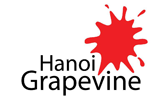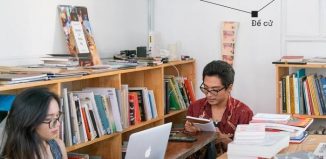Puppetry as Alchemy: A conversation with Linh Valerie Pham
Written by Van Do. Hanoi Grapevine re-posted with permission from The Factory Contemporary Arts Center. Please credit the sources when sharing
Copies and re-posting of any parts of the article without permission are not allowed

I first met Linh Valerie Pham a few years ago when she just returned to Vietnam from the US, then bumped into her again at Nha San Collective where she contributed a performance piece to IN:ACT 2017 (an annual festival of performance art), and another time I sat with her at Manzi to discuss her upcoming personal project of experimental theatre. She soon founded the first puppet collective in Hanoi called ‘Mat Tran Ensemble’, carrying out many other community art projects simultaneously, one of their most recent projects being a one-month intimate travel to ethnic communities of their dear friends ‘The Pioneers’. Constantly, yet effortlessly, they are always doing something, always exuding the fullest of life. Being ‘alive’ is central to ‘Mat Tran Ensemble’ and Linh’s artistic language; with light, movement, breath, projection and shadow all casting life in their puppet beings. Excitement, and a congratulatory sense is mounting towards the long-awaited ‘Gạo’, a full-length theatrical play inspired by a historical point in Vietnam’s collective memory that is gradually swirling in oblivion,finally headed home (show dated June 29th at The Factory Contemporary Arts Center) after its voyages to New York and Yogyakarta.
Van Do (VD): What propelled you to the art of puppetry and that of Japanese Bunraku puppet tradition specifically?
Linh Valerie Pham (LVP): When I was studying at Sarah Lawrence College (USA), I had an opportunity to be trained under the guidance of the puppet artist Tom Lee (War Horse) and got to know Prof. Dan Hurlin, both of whom are pioneers in American contemporary puppetry. Both of them were majorly influenced by Bunraku, the Japanese traditional puppet theatre – especially my teacher Tom Lee, who studied under the fifth generation of Kuruma Ningyo puppet theatre, sensei Koryu Nishikawa V. Therefore, it is inevitable that I got much inspiration from Japanese puppetry.
VD: Compared to traditional Bunraku puppet theatre, how have you transformed and created your own artistic and puppet language? In the future, how do you think you will develop it further?
LVP: After graduation, I had many opportunities to perform and collaborate with different artists and theatres, such as Stephan Kaplin (Chinese Theatre Works), Kevin Augustine (Lone Wolf Tribe), Huahua Zhang (Visual Expressions), Susan Vitucci, and Jeanette Yew. Therefore, I have familiarized myself with a diverse range of puppet styles and traditions, particularly rod puppetry, shadow puppetry or theoretically termed ‘object theatre’. All of these experiences have contributed and enriched my own language beyond the pure Bunraku. However, my practice is also informed by other puppet traditions, such as Bunraku (the traditional Japanese puppet theatre), Wayang (Indonesian shadow puppetry) and other theatrical elements such as lighting, installation or video projection.
When introducing myself as a puppet artist, I feel like I am over-simplifying my artistic practice. I see myself as a storyteller, and puppetry as something beyond dancing with the ‘caricatures’. To me, puppetry is a way to explore breathing and extending the intimacy between puppeteers and puppets in order to tell stories in motion with images, movement and imagination. Just like other art forms, puppetry resembles alchemy, in which it transforms, matures and perfects certain objects and materials.
VD: What do you mean by comparing puppetry with alchemy? Conceptually, how do you develop your practice? For example, what is the most significant part of this transformation process, of turning puppets into living beings?
LVP: Alchemy can be understood as turning inexpensive metals into gold, which is, essentially speaking, to transform. For me personally, every art form is like that – experimenting with different materials to transform something into another, turning pigments into a painting, film slides into a movie, or a piece of scrap paper into a living and breathing being.
Puppetry, to me, is telling stories with the breath and materials, not just as popularly considered theatrical ‘caricature’. My puppet practice does not separate the puppet and its puppeteer. Instead, a puppet is an extension of the puppeteer. Different materials carry within themselves different qualities, capacities and languages. And sometimes, the puppet can even do something that humans cannot. For example, when they wave the national flag to praise something, the way the flag is swinging, floating, hovering in the air or dancing with the winds already demonstrates the outburst of exhilaration of the person waving it. Those who look at it can also feel it. The flag thus becomes the extension of the person that waves it. To me, this is the essence of puppetry.

VD: What distinguishes puppetry from other art forms?
LVP: I really like this quote of my teacher’s teacher, sensei Koryu, who used to tell me: “If people do certain things, it can look very cheesy. But if puppets do them, it’s fine.” Perhaps, the puppets originally come from another world. It’s their presence and breathing that invite and enclose the audience into another spatial dimension of the world and they will be asked to accept another parallel reality.
VD: When you just returned to Vietnam, how were you and your artistic practice received? How has it changed over the years with you inwardly and with the general perception of this kind of puppetry?
LVP: When I returned, I was met with a little difficulty in terms of my artistic practice. Back then, most of the puppet artists were working for the State-owned theatres and performing in certain ways. Moreover in Vietnam, puppetry is not a popular art form. For many, puppetry is only for two audiences, tourists and children. But even in the children’s eyes today, the magic of puppetry is also fading, losing it to animation and smartphones.
However, I am lucky enough to be able to participate in many community art projects that could introduce my art to a larger audience through those channels. The communities I worked with had little to no exposure to puppetry of any kind – such as Đăk R’ Măng children in Central Highlands of Vietnam, university students in Hanoi – so they came to know puppetry and saw it under a very different, yet fresh light. In a way, it’s also part of the reason why I was driven to found Mat Tran Ensemble: it’s when I realized that, due to some particular reasons, only few groups of people can have access to the “arts”, which means that others’ stories and voices are left out.
VD: So how do you differentiate your personal practice with Mat Tran’s practice? How do they complement each other?
LVP: In my own artistic practice, I tell my stories from my own point of view while Mat Tran Ensemble’s projects are results of co-creation (with the word ‘ensemble’, an English word originating from French, meaning being together at a point in time). For example, with this play ‘Gạo’, at first glaces, it might not appear as a community-based art, but the way we develop it resembles that of an ‘ensemble’. Everyone involved contributes to the improvisation and development of it.
VD: How were you inspired by the Vietnamese Great Famine in 1945 to create this play ‘Gạo’ (Rice)?
LVP: ‘Gạo’ was preceded by a short theatrical piece commissioned by Drama of Works during a puppet festival called Punch: Kamikaze. Participating artists of that festival were invited to make works in response to World War II. So I and one of my close friends and collaborators, Leah Ogawa, a Japanese-American, decided to choose this subject matter because that historical event is where our personal histories and stories intersect.

VD: Could you share more about this collaboration? How did each of you contribute to the process of making this work? Standing from two different perspectives to look at one specific point in time, how did you both connect to the history of the other?
LVP: Leah and I had already collaborated several times before. Ever since we were at university, we were both involved in the production of ‘Tea’, a play about war brides. I was the director and Leah was the lead actress. When we started to discuss ‘Gạo’, the first thing we did was research and consider its dramaturgy. I read materials in Vietnamese and she in Japanese. After that we gathered the information together in English to share with each other. What we came up with was stories seen from different points of view. Perhaps, that is why the focus of ‘Gạo’ (Rice) is not “putting blame” on or finding out the penetrators, but the humanity under pressing circumstances.
VD: I am not very familiar with the Vietnamese traditional puppetry. I also question the necessity of having to put your art practice in relation with the traditional Vietnamese puppetry (múa rối nước). Are you concerned with the locality in your work? Have you ever thought of working with Vietnamese traditional puppetry?
LVP: Locality and tradition are both very significant to me. But I completely disagree if someone says that I am not “Vietnamese” enough, simply because I don’t use rối nước or tuồng, chèo. Rối nước was originally created by the peasants strongly wired to their water, mud, land. Mr. Đình Bảy (a puppeteer from the Nguyên Xá Troupe) dislikes wearing safety shoes while performing because he likes to dip his toes into the mud. I am an urban dweller and I study under Western teachers, experiencing no single day of laboring on the farm, thus my practice has to differ. That being said, I do not think that my artistic practice does not carry its own Vietnamese identity. Actually I think that this identification of ‘Vietnameseness’ too often refers only to the surface. I personally think that the works I produced in the last 3 years living in Vietnam have a strong connection to the story of a modern Vietnam, which adds an alternate narrative to the traditional productions by the national puppet theatres.
It is not that I have never thought of working with Vietnamese traditional puppetry. But I think it is not the right time yet, and I am not eligible enough to be the one doing that as well.
VD: Thank you for your time!
* ‘The Pioneers’, an abbreviated name for ‘The Pioneers for the Voice of Ethnic Minorities’, is a representative group for ethnic minorities across Vietnam, comprised of representatives of 15 ethnic communities from 11 provinces across Vietnam.
** Bunraku is Japanese traditional puppet theatre in which half-life-size dolls act out a chanted dramatic narrative, called jōruri, to the accompaniment of a small samisen (three-stringed Japanese lute). Source: Britannica.
















